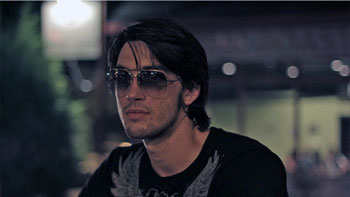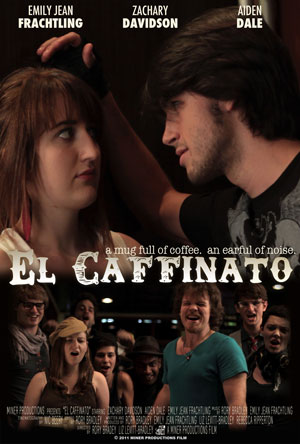The Makers of El Caffinato
by Margot C. Lester
One of the most talked-about films at the Carrboro Film Festival last month was the Western musical El Caffinato, created by husband-and-wife filmmakers Rory Bradley and Liz Levitt-Bradley of Carrboro. It was the film’s festival premiere, and it won Best Film honors.
The short rock-opera follows the traditional Western plotline, featuring hipsters in a contemporary coffee shop. The reluctant hero, Milo, is heartbroken at being ignored by the barista, Pepper. When a “menacing stranger†intrudes on the café, Milo has to rise to the occasion.

“We got to have all the fun of making a Western without having to find horses or carriages or anything like that,†Bradley notes. “We still had cowboy boots though.â€
Inspiration for the film came from a genre featured in the 48 Hour Film Project, Musical/Western. The festival intended for filmmakers to choose one or the other, but the combination of the two piqued the Bradleys’ interest.
“We started contemplating how fun and humorous it could be to combine them,†Levitt-Bradley laughs.
Making movies
The film was planned using storyboards Levitt-Bradley painstakingly produced.
“Liz drew over 140 images envisioning every shot that we wanted in the movie,†Bradley recalls. These – along with videos; clips from Mad Men and Kick Ass; and photographs, including shots of coffee cups and café tables – were sent to local cinematographer Nic Beery to create the look and feel of the film.
The story was shot mostly at Jessee’s.
“Everything from the wall colors to the pressed tin ceilings, the roaster room and the back bar made it really ideal for our project and captured the aesthetic that we wanted,†Levitt-Bradley says. The cast and crew shot eight script pages in 10 hours on a one-day shoot at Jessee’s. The industry standard is typically only two pages in 12 hours.
Hand in hand
Collaborative creation is the Bradleys’ preferred M.O. They met at Wesleyan University and have collaborated on art and in life ever since. In 2010, they enrolled in The Peoples Channel’s field editing class and decided to give filmmaking a try. Though El Caffinato is their first film project together, both worked in the performing arts for many years.
“As the daughter of a professional mime, I grew up understanding that the performing arts are an important and essential part of life,†says Levitt-Bradley, who got into theatre at age nine. Bradley got his start as a college freshman, working on an independent feature called Rounding First in Pennsylvania.
For the El Caffinato book, the Bradleys collaborated with Emily Jean Frachtling and Rebecca Ripperton, former students of theirs at the Emerson Waldorf School. The foursome wrote the lyrics in about three days, going through the story chronologically.
“When we each had material, we’d share it aloud and begin picking and choosing lines, mixing and matching great phrases or great words until we had dialogue that we were proud of,†Levitt-Bradley explains.

“With our four voices blending together, the characters became more dynamic and multi-dimensional. When a character’s lines encompass each writer’s subtly different ideas, you really start to get a sense of the movement and activity of that character’s thoughts. They start to seem more real and believable, even if they are singing all their words in a highly improbable reality. Every lyric in the script was written in this collaborative fashion.â€
Then the Bradleys paired up to work out the melodies and chord progressions on guitar and piano over a couple of days. Bradley followed that up with a long weekend “with a digital recorder and all of my instruments spread around on the floor of our office, recording the instrumentation you hear in the movie,†he says.
Your latest trick
Speaking of recording, get this: No sound was recorded on set.
“Every sound effect, footstep, piece of dialogue, cup clink, leather skirt squeak – all of that was created by Liz and Aiden Dale [aka Dusky Dan Digby] and recorded after the fact, then synced up with the movie,†Bradley explains.
Levitt-Bradley developed a talent for sound effects while she and her husband worked on an original radio drama on WESU, at Wesleyan.
“We built a makeshift sound booth out of cardboard and clearance foam egg crate bed toppers. Actors came over and recorded their parts one by one, watching a rough cut of the movie on a monitor that we set up in the cardboard booth and trying to match what they saw on screen. The final sound mix had something like 35 different layers, because you have to mix all of those things in separately.â€
The filmmakers are submitting El Caffinato to a number of other film festivals, which means, ironically, that if you missed it at the festival, you won’t be able to see it for the near future. You can, however, check out the trailer at vimeo.com/30657963
Once upon a time in the West
For these filmmakers, Carrboro’s got it all.
“We love the sense of community here, as well as the lively sense of activity,†says Levitt-Bradley.
“What sums it up for me is that everything relating to El Caff happened in about a 2-mile radius,†her husband adds. “We live up the street from Jessee’s, which is a block or so from Nic’s office and the Carrboro ArtsCenter, where we also filmed, and another block from where the film debuted at the Carrboro Film Festival in the Century Center before a huge crowd of people who turned out to support local films. That’s what this town is like – it’s a small place filled to the brim with creative happenings and great food and a strong community feeling.â€